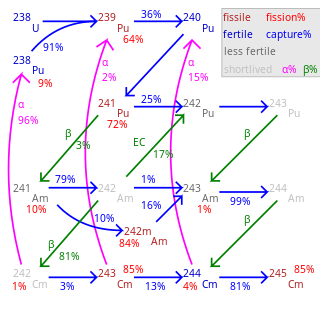Top Qs
Timeline
Chat
Perspective
Plutonium-241
Isotope of plutonium From Wikipedia, the free encyclopedia
Remove ads
Plutonium-241 (241
Pu, Pu-241) is an isotope of plutonium formed when plutonium-240 captures a neutron. Like some other plutonium isotopes (especially 239Pu), 241Pu is fissile, with a neutron absorption cross section about one-third greater than that of 239Pu, and a similar probability of fissioning on neutron absorption, around 73%. In the non-fission case, neutron capture produces plutonium-242. In general, isotopes with an odd number of neutrons are both more likely to absorb a neutron and more likely to undergo fission on neutron absorption than isotopes with an even number of neutrons.
This article needs additional citations for verification. (November 2021) |
Remove ads
Decay properties
Summarize
Perspective

Plutonium-241 is a beta emitter with a half-life of 14.33 years, corresponding to a decay of about 5% of 241Pu nuclei over a one-year period. This decay has a Q-value of only 20.8 keV, and does not emit gamma rays.[3] The longer spent nuclear fuel waits before reprocessing, the more 241Pu decays to americium-241, which is nonfissile (although fissionable by fast neutrons) and an alpha emitter with a half-life of 432.6 years; 241Am, which does emit gamma rays, is a major contributor to the radioactivity of nuclear waste on a scale of hundreds to thousands of years.[citation needed] In its fully ionized state, the beta-decay half-life of 241Pu94+ decreases to 4.2 days, and only bound-state beta decay is possible.[4]
Plutonium-241 also has a rare alpha decay branch to uranium-237, occurring in about 0.0025% of decays. Unlike its usual beta decay, this can emit gamma rays, X-rays, and associated electrons.[1]
Remove ads
References
Wikiwand - on
Seamless Wikipedia browsing. On steroids.
Remove ads